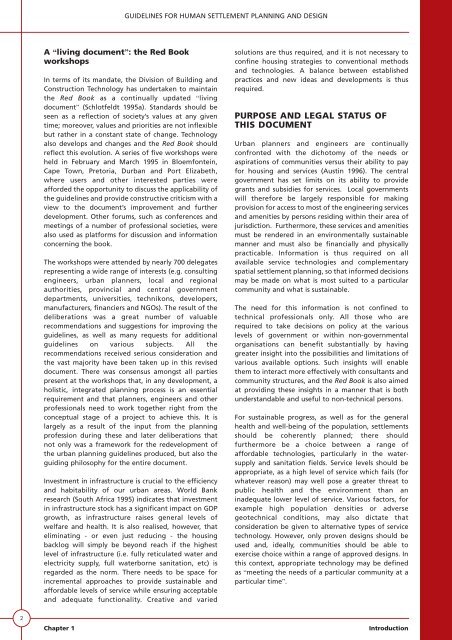VOLUME 1 HUMAN SETTLEMENT PLANNING AND ... - CSIR
VOLUME 1 HUMAN SETTLEMENT PLANNING AND ... - CSIR
VOLUME 1 HUMAN SETTLEMENT PLANNING AND ... - CSIR
- No tags were found...
Create successful ePaper yourself
Turn your PDF publications into a flip-book with our unique Google optimized e-Paper software.
GUIDELINES FOR <strong>HUMAN</strong> <strong>SETTLEMENT</strong> <strong>PLANNING</strong> <strong>AND</strong> DESIGNA “living document”: the Red BookworkshopsIn terms of its mandate, the Division of Building andConstruction Technology has undertaken to maintainthe Red Book as a continually updated “livingdocument” (Schlotfeldt 1995a). Standards should beseen as a reflection of society’s values at any giventime; moreover, values and priorities are not inflexiblebut rather in a constant state of change. Technologyalso develops and changes and the Red Book shouldreflect this evolution. A series of five workshops wereheld in February and March 1995 in Bloemfontein,Cape Town, Pretoria, Durban and Port Elizabeth,where users and other interested parties wereafforded the opportunity to discuss the applicability ofthe guidelines and provide constructive criticism with aview to the document’s improvement and furtherdevelopment. Other forums, such as conferences andmeetings of a number of professional societies, werealso used as platforms for discussion and informationconcerning the book.The workshops were attended by nearly 700 delegatesrepresenting a wide range of interests (e.g. consultingengineers, urban planners, local and regionalauthorities, provincial and central governmentdepartments, universities, technikons, developers,manufacturers, financiers and NGOs). The result of thedeliberations was a great number of valuablerecommendations and suggestions for improving theguidelines, as well as many requests for additionalguidelines on various subjects. All therecommendations received serious consideration andthe vast majority have been taken up in this reviseddocument. There was consensus amongst all partiespresent at the workshops that, in any development, aholistic, integrated planning process is an essentialrequirement and that planners, engineers and otherprofessionals need to work together right from theconceptual stage of a project to achieve this. It islargely as a result of the input from the planningprofession during these and later deliberations thatnot only was a framework for the redevelopment ofthe urban planning guidelines produced, but also theguiding philosophy for the entire document.Investment in infrastructure is crucial to the efficiencyand habitability of our urban areas. World Bankresearch (South Africa 1995) indicates that investmentin infrastructure stock has a significant impact on GDPgrowth, as infrastructure raises general levels ofwelfare and health. It is also realised, however, thateliminating - or even just reducing - the housingbacklog will simply be beyond reach if the highestlevel of infrastructure (i.e. fully reticulated water andelectricity supply, full waterborne sanitation, etc) isregarded as the norm. There needs to be space forincremental approaches to provide sustainable andaffordable levels of service while ensuring acceptableand adequate functionality. Creative and variedsolutions are thus required, and it is not necessary toconfine housing strategies to conventional methodsand technologies. A balance between establishedpractices and new ideas and developments is thusrequired.PURPOSE <strong>AND</strong> LEGAL STATUS OFTHIS DOCUMENTUrban planners and engineers are continuallyconfronted with the dichotomy of the needs oraspirations of communities versus their ability to payfor housing and services (Austin 1996). The centralgovernment has set limits on its ability to providegrants and subsidies for services. Local governmentswill therefore be largely responsible for makingprovision for access to most of the engineering servicesand amenities by persons residing within their area ofjurisdiction. Furthermore, these services and amenitiesmust be rendered in an environmentally sustainablemanner and must also be financially and physicallypracticable. Information is thus required on allavailable service technologies and complementaryspatial settlement planning, so that informed decisionsmay be made on what is most suited to a particularcommunity and what is sustainable.The need for this information is not confined totechnical professionals only. All those who arerequired to take decisions on policy at the variouslevels of government or within non-governmentalorganisations can benefit substantially by havinggreater insight into the possibilities and limitations ofvarious available options. Such insights will enablethem to interact more effectively with consultants andcommunity structures, and the Red Book is also aimedat providing these insights in a manner that is bothunderstandable and useful to non-technical persons.For sustainable progress, as well as for the generalhealth and well-being of the population, settlementsshould be coherently planned; there shouldfurthermore be a choice between a range ofaffordable technologies, particularly in the watersupplyand sanitation fields. Service levels should beappropriate, as a high level of service which fails (forwhatever reason) may well pose a greater threat topublic health and the environment than aninadequate lower level of service. Various factors, forexample high population densities or adversegeotechnical conditions, may also dictate thatconsideration be given to alternative types of servicetechnology. However, only proven designs should beused and, ideally, communities should be able toexercise choice within a range of approved designs. Inthis context, appropriate technology may be definedas “meeting the needs of a particular community at aparticular time”.2Chapter 1Introduction
















